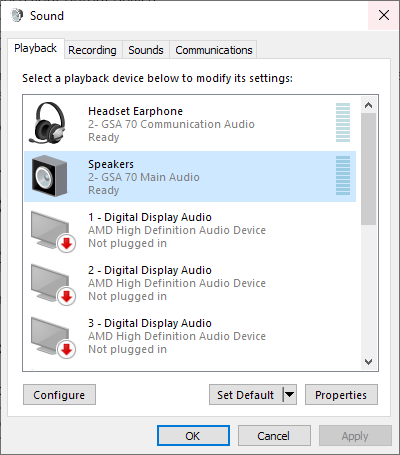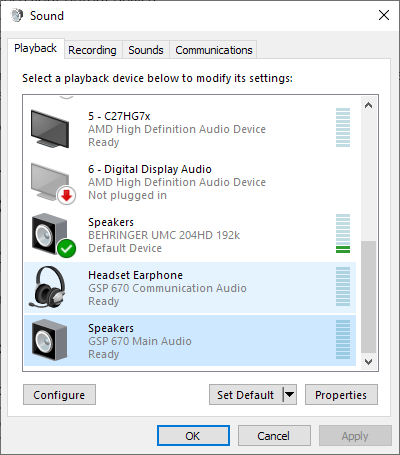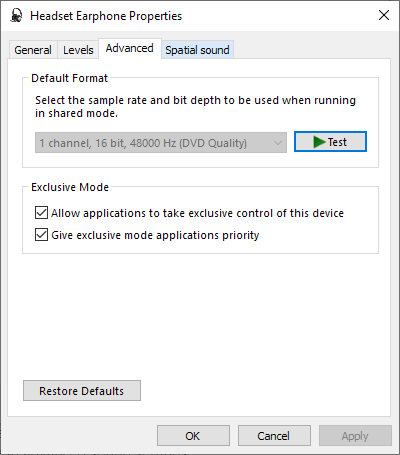The Sennheiser GSP670 Wireless Gaming Headset Review: Cutting The Cord
by Andrei Frumusanu on July 5, 2019 8:00 AM EST- Posted in
- Gaming
- Headset
- Audio
- Sennheiser
- GSP670
Software & Functionality
Software functionality of the GSP670’s are quite straightforward if you’re running Windows 10; the headphones are simply plug & play both through the GSA70 adapter as well as if you directly connect the headphones via USB. However when you connect both, there’s some interesting side-effects:
Connected both ways, you get 4 audio devices in your sound settings. The GSP 670 entries are the USB connector entries, while the GSA 70 are the wireless dongle connections. However these do not work in parallel; you only have either pair of main and communications audio working, and playing back anything on the other pair will result in no effect.
In terms of details of what the “Communication Audio” is: this is essentially secondary sound channel muxed into the primary audio. However this again isn’t a second full blown audio device as playback is limited to a single mono channel at 16bit 48KHz, with the same characteristics on the microphone recording device.
Playing back audio through the main audio and the communication audio is possible, with the communication audio being overlaid on top of the main audio. The mux happens on the headphone audio SoC, and it’s possible it’s the main source of some further issues we’ll cover in the testing section.
Volume control of the communication audio is done by either the usual sound panel in the OS, or through the dedicated knob on the right side of the headphones. It’s to be noted that this secondary volume knob is relative to the primary volume control of the headphones, meaning that they’re not independent of each other and volume of the communication audio depends on both the secondary as well as primary volume knob controls.
In terms of Bluetooth connectivity, it’s a bit complicated as well. First of all, I didn’t manage to pair any BT device to the headphones while they were connected to the GSA70 dongle. Unplugging the dongle I finally managed to pair my phone.
When not in range of the GSA70 and connected via BT, the headset works as any other BT headset. This also means just one main playback device.
When connected to the GSA70, the BT connection is not able to play back anything and will only engage if you’re receiving a call on your phone. The most annoying aspect here and Sennheiser didn’t seem to think of, is that there’s no way to purposefully actually play back anything over BT if you’re still connected to the GSA70 and in range. Unplugging the dongle is the only way to actually do this.
While not strictly necessary, Sennheiser also offers the “Gaming Suite” application which gives you a few basic controls for the headphone audio as well as serving as an update application for the headphone’s firmware.
Amongst the more basic features, it offers a 5-band equalizer with a few pre-sets such as flat targets, a V-shaped music target and a competitive gaming target which dismisses most low-end frequencies for augmented treble.
The headphones also offer a 7.1 surround sound mimicking setting which gives one the impression of a wider sound stage and one can fine-tune the reverberation amount. I’m not too big of a fan of this and find it detrimental, but apparently some people like it.
The software also offers some basic microphone adjustment features, however I found some features currently not working. In general it seems like Sennheiser’s software suite is a bit incomplete – however it’s something the company openly admits and promises continued development in the coming months.
The biggest issue I found with the software suite is that it’s seeming incompatible with third-party APO plugins, which was a bit of a deal-breaker for me so I left it uninstalled during my general usage.


















29 Comments
View All Comments
bunkle - Friday, July 5, 2019 - link
Agreed. There are many closed circumaural headphones that sound great. I use a closed backed Beyerdynamics DT 150 but there are many more depending on your taste: https://diyaudioheaven.wordpress.com/BenSkywalker - Friday, July 5, 2019 - link
Has there ever been a closed can that sounded better than an all else identical open one? Ever?Yes, a good set of closed cans will sound better than garbage open ones, but all else equal I've yet to see an example where the open headphone was not markedly superior.
bunkle - Friday, July 5, 2019 - link
"Sounds better" is highly subjective sweeping generalization but you certainly get closed headphones that have similar frequency response, distortion and harmonics up there with the best open backs. A nice example is the MrSpeakers Aeon that comes open and closed. Again completely subjective whether the closed "sounds better" but it's well regarded.whyaname - Friday, July 5, 2019 - link
I made an account just to reply to this.Sony R10
Apparently the best dynamic closed headphone ever made.
If you read about them, they are often compared to even the best electrostatic headphones there are.
They have the "advantage" of being closed and thus isolating the listener from unwanted background noise.
Sony only produced from what I remember roughly 2000 units as they apparently made a losswith every sold unit as it was a more of a "look we can" than "this exists to actually make money" kinda thing.
They developed together a biotech company a bacteria that produced the biocellose that was used for those cans.
Lots of other over the top stuff for them.
I really would like to get the chance to listen to a pair, but they are just that rare.
I read that someone that bought them back in the day in england had some higher up from Sony personaly deliver the headphone.
ZolaIII - Saturday, July 6, 2019 - link
Sony in the particular case used organic diagrams that ware approximately an order of magnitude thinner than usual & much more elastic but the same material would simply be to fragile for a open design. It always whose a very hard task to achieve a good implementation even with big resonance boxes for speakers involving additional barriers it's an art to be more precise. Same simply can't be used on headphones.iamlilysdad - Monday, July 8, 2019 - link
Did they make an open version of the R10 to compare the closed version to? If not, then that does not answer the question.The closest comparison I can think of the Sennheiser 800s compared to the 820. Open and closed of the same headphone.
BenSkywalker - Friday, July 5, 2019 - link
Air pressure?Either your headphones don't isolate so you get proper airflow, or they do isolate and you get echo/reverb issues.
ZolaIII - Saturday, July 6, 2019 - link
Simple as it is drivers need to dance (actually diagrams do). When ordinary materials used it's much easier to secure more optimal ripples with something that has a air flow than with something that is siled up. I prefer semi open back over the ear headphones. There are examples of closed back headphones which achieve outstanding bas (where cans need to dance the most) but those are rare (MEE 6 Pro being the last surprising one's in my case even more because those are tiny in ear [achieved true dancing driver]), they simply cannot have the sound stage as wide as open one's equally made.astrocramp - Saturday, July 6, 2019 - link
I prefer open back also, with one huge advantage other than sound that you can hear what's going on around you. I use Audiotechnica for gaming, but I don't think I've ever seen a wireless open back headset outside of the real expensive wireless audiophile Sennheisers (with no mic).willis936 - Friday, July 5, 2019 - link
Excellent work. It would be cool to see phase plots for latency measurements in future wireless testing. I’m not sure if test software is capable of sending samples to two drivers at the same time, as that would be important.